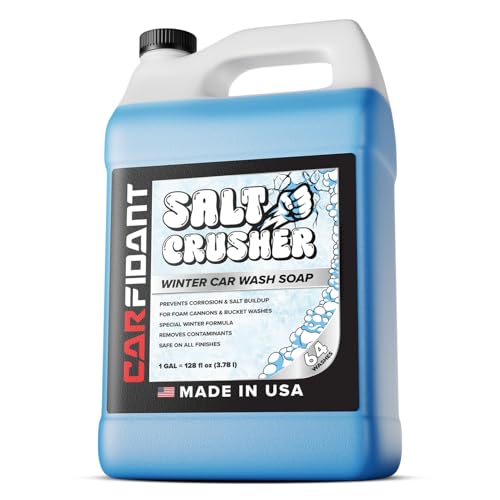Links to Amazon and other retailers on this page can be affiliate links or other sponsored advertising.
When you click and/or make a purchase, JADCOM Media LLC may earn a small commission. Thank you.
Rust damage ranks as one of the most common issues that can harm the lifespan and your car’s visual appeal. Neglecting it often leads to serious damage, expensive fixes, and lower resale values.
The good news is there are preventive measures car owners can take to prevent car corrosion and keep your beloved car looking flawless. Whether you’re a seasoned driver or a first-time car owner, the best way is to be proactive, which can be the difference between a pristine car’s body and solid performance, and well… a compromised one.
Corrosion is perhaps the most common and destructive problem vehicle owners face. Over time, rain, road salt, and environmental factors can lead to corrosion and rust formation, compromising your structural integrity and aesthetics. You can prevent corrosion and keep your auto in good condition for years to come by following the right preventive measures.
If you live in an area that experiences harsh winters, road salt accelerates the rusting process, and therefore, regular maintenance is necessary.
Auto repair shops tend to find severe corrosion damage that might have been prevented through simple protective methods. No matter if you have a brand-new model or an older auto, these easy but effective ways will help you maintain your car in excellent condition and save you money on repairs.
How Rust Forms
Rust, also known as iron oxide, is formed through a chemical reaction between oxygen, water, and metal. Once it starts, it will weaken the body, impacting your car’s appearance, and can lead to structural damage if left unattended.
Causes of Rust
First, it is important to understand the causes of oxidation spots. The reaction is especially common in areas where road salt is used during winter.
The salt increases the growth of corrosion by increasing the water conductivity so that the reaction can occur more readily. Oxidation spots are caused by:
- Road salt and saltwater speed up corrosion.
- Bird droppings, sticky tree sap and road residue deteriorate your car’s finish.
- Paint chips and scratches expose the metal surface to rust.
- Rain and high humidity lodge water in door frames and wheel wells.
Fortunately, many quality auto repair shops in areas that use road salt can help. For example, in Missouri, quality auto repair shops in Springfield can help with professional rust repair, early detection, and maintenance techniques that protect your auto.
How to Prevent Rust on Your Car
Early treatment is the best defense against corrosion. Here’s how to guard against it:
Wash Your Car Often
One of the simplest but most useful methods of corrosion prevention is frequent washing. Dirt, salt, and road grime ensnare moisture, leading to accelerated corrosion, particularly in vulnerable areas like the wheel wells and the bottom of the vehicle.
Pay attention to:
- The underside of the car, where road salt accumulates
- Wheel wells and door frames, which are vulnerable areas
- The undercarriage of your car is often neglected
Regular washing of your auto, preferably multiple times every winter season or at least more frequently than “occasionally,” reduces your chances of developing oxidation.
For best results, visit a professional car wash during the winter months, as they use high-quality products to remove salt and grime effectively.
Utilizing a professional-quality auto wash, naturally, is ideal, but even washing one’s auto at home can do some good, if done properly with the appropriate materials.
Apply Protective Coating
A protective barrier shields your car’s surface from moisture and oxidation. Consider these options:
- Car wax: Putting a coat of wax on every few months provides an added layer of protection.
- Rust inhibitors: Use rust-inhibiting sprays for the bottom of the vehicle to get ahead of corrosion.
- Ceramic coatings: These provide long-lasting paint protection.
- Paint protection film: Stops chips and scratches.
When you spot early oxidation, use touch-up paint on bare metal to avoid costly repair. In addition to washing, a protective coat is among the best preventatives. A coat of wax is like armor between your auto’s paint and the harsh weather.
Any barrier you provide helps to keep your car in prime condition while it protects against surface oxidation and minor scratches, that can lead to more significant damage.
For even better results, use premium products like paint protection film or ceramic coatings. The benefits of ceramic coatings are longer protection and lower maintenance.
Repair Paint Damage Immediately
Small scratches and paint chips can lead to serious damage if left untreated. To prevent oxidation spots:
- Touch-up paint immediately when you notice the damage.
- Use a rust converter if you see surface rust.
For heavier rust, take your vehicle to a reputable car repair shop to have corrosion fixed professionally. Maintaining the paint on your vehicle is also a critical part of driving an oxidation-free car. Paint chips let water and air reach the metal below, and the metal will oxidize.
Check your car’s paint for damage regularly and correct any issues immediately. Small scratches and bare metal must be addressed immediately with touch-up kits to prevent rust from beginning.
Dry and Cover Your Car
Water is rust’s best friend. But there are things you can do to impact that friendship:
- Park in an enclosed garage or parking lot.
- Use car covers like a Zerust car cover to keep out humidity.
- Use rubber floor mats that don’t trap moisture in the vehicle.
Rust-Proof the Undercarriage
The car’s underbody is most susceptible to road salt and debris. Protect it with:
- An undercoating sealant to keep out moisture.
- Consider cathodic protection for advanced corrosion protection.
- Have the underbody areas of your car inspected on a regular basis.
Treat Rust Spots Early
Not treating oxidation signs in their early days can lead to expensive repairs later on. For minor rust spots, act quickly:
- Sand the oxidation spots gently.
- Treat with an oxidation spot converter to destroy corrosion.
- Primer and touch-up paint to seal.
Park Your Car Appropriately In Winter
Another excellent rust prevention strategy is to park wisely. If possible, use a garage or covered parking spot so that your vehicle is protected from rain, snow, and high humidity—all oxidation spot inducers.
During harsh weather, car covers are the additional protection your vehicle requires. They act as a protective barrier to keep moisture from adhering to your vehicle’s body.
Harsh winters speed up corrosion formation. Protect your car from damage by:
- Regular washing to remove road salt.
- Spraying a rust inhibitor before winter.
- Park it in a dry, covered area.
Inspect Hidden Areas for Rust
Oxidation spots like to start where you won’t notice them. Be sure to check:
- Behind wheel wells
- Underbody panels
- Around door frames and trunk seals
Apply High-Quality Rust Prevention Products
Not all products are created equal. Concentrate specifically on:
- Long-lasting rust inhibitors
- High-quality ceramic or polymer sealants
- Long-lasting car covers for parking outdoors
Preserve Your Car’s Resale Value
As a detailer, you know the value of keeping your car’s condition managed. Keeping a vehicle rust-free not only keeps it looking great, but it holds its resale value, too. By taking these simple steps, you’ll keep your favorite vehicle in great condition for years to come.
Best Ways to Prevent Rust
Use a Rust Inhibitor
It is also important to look at the bottom of the vehicle. The underside is a prime target to oxidation due to its constant contact with road salt, water, and dirt.
Spraying a rust inhibitor or using undercoating can form a protective layer that shields the metal surface from corrosive materials.
Don’t miss the areas of your vehicle, such as door frames and body panels, that are often neglected but are no less vulnerable.
Regular Inspections
Regular inspections are necessary to catch oxidation spots early. These small spots can be treated with touch-up paint or rust converter before they become larger issues.
As mentioned earlier, areas more prone to corrosion, like car repair shops in Springfield, Missouri offer inspections. These are often part of their regular maintenance packages to catch oxidation spots in the first place.
Use Rubber Floor Mats
You should also know the effects of seasonal variations. Winter months are particularly demanding on vehicles because of excessive use of road salt and snow, and ice.
Taking preventive steps like using rubber floor mats, which prevent salt and moisture from entering the interior of the cabin, and frequently washing the underside of the vehicle, can assist in increasing the lifespan of your vehicle.
Cathodic Protection
It’s also fun to explore more advanced techniques like cathodic protection, which employs electrical currents to repel oxidation.
While perhaps more common in industrial or marine applications, some high-end vehicle protection systems include similar features to repel oxidation. While not needed by all drivers, it’s another tool in the toolbox for those who want the best oxidation spot protection.
Importance of Drying
Never underestimate the importance of allow things to dry out. When washing or during rain exposure, make sure that your vehicle has a chance to dry to keep moisture from remaining on the vehicle’s surface. Moisture would get stuck within seams and below trim pieces and start the process of rusting in hidden areas or hard-to-reach spaces.
Final Thoughts
Rust does not have to ruin your auto. Early detection, regular maintenance, and protective coverings will prevent car rust and costly repairs. You can do it yourself or visit auto repair shops, but doing it now will extend the life of your car and keep it looking fantastic.
Preventing corrosion requires more than occasional attention. It requires an active approach and frequent maintenance to detect and halt corrosion before it becomes an issue.
From frequent checks and early detection to the use of protective coating and the avoidance of damaging substances, the way to a rust-free vehicle is straightforward. Keep in mind that corrosion isn’t merely a surface problem—it has the potential to cause costly repairs and shorten the life of your vehicle.
By following these simple, practical steps and keeping up the same car maintenance routine, you can enjoy your favorite ride in top condition for the years ahead.
Stay on top of things, and your efforts will pay you back!






